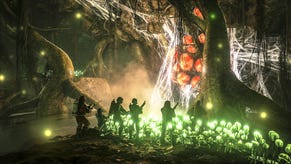Ark: Survival Evolved is out of Early Access but still needs work
Console performance just isn't good enough.
There was a time when Digital Foundry would produce bespoke performance videos - and indeed Eurogamer articles - for virtually every major release. With so many games seemingly rushed to market, how well a particular title would run was a crucial factor in any purchasing decision. Thankfully, quality in this area is much improved across the board, but in the case of Ark: Survival Evolved, performance remains a major weakness for the game - even now, after finally emerging from Early Access.
Before we go on though, we would like to stress that in terms of its concept and in much of its gameplay implementation, Ark: Survival Evolved really is great fun - an aspect of the experience we've discussed in the past, and clearly, the title has caught the imagination of the userbase. After all, every version of the game has racked up sales in the millions. But the fact remains that Ark has always performed in a sub-optimal fashion and even now, the title still runs poorly.
While the game remained in Early Access, Studio Wildcard deserved the benefit of the doubt. Unreal Engine 4 has proved tricky for some developers to work with, and the scale and scope of Ark: Survival Evolved is clearly daunting. The fact that the game was a work-in-progress was clearly signposted to users, so the very low resolution and choppy frame-rate was perhaps forgivable. However, revisiting the game in its final release form only sees iterative improvements to performance and by and large, it feels similar in many ways to its work-in-progress showing.
Effectively, there are three console versions available to play right now - PlayStation 4 Pro, base PS4 and Xbox One (with X to follow). The Sony platform benefits from two modes: normal and detail. As far as we can tell, there's little actual improvement in terms of detail by opting for the latter option - it simply offers up a higher resolution. Normal mode, runs at 720p on Pro (yes, really) and a blurry 640p on base (this is an approximate measurement: the game is so blurry, pixel-counting is very difficult) while the detail mode offers up 720p on the standard PS4 and 1080p on Pro.
Where the final code attempts to improve on its pre-release showing is in its implementation of v-sync. Three options are available: on, off and adaptive. In all cases, Ark runs with an unlocked frame-rate, meaning that with v-sync on, the game can switch rapidly between fps counts divisible by a 60Hz display - 60fps, 30fps, 20fps, 15fps. Depending on how busy the game is, the double-buffer set-up jars awkwardly between these states. Just like a PC game, v-sync can be disabled, effectively trading the jarring jumps for a smoother experience, albeit one blighted by continual, unavoidable screen-tearing.
The arrival of the adaptive option changes things up though. Many console titles lock to 30fps as their performance target, dropping v-sync when dipping beneath, resulting in occasional screen-tear - it's the console standard adaptive v-sync implementation. Ark does things a little differently though, tearing beneath 30fps but retaining an uncapped, v-sync presentation otherwise, meaning you still jump between 30 and 60fps in less busy scenes. By and large, Ark's adaptive mode is the best option though, and for PS4 Pro users running in the detail mode, much of the game plays out at 1080p30 with some tearing. This makes it the best console version of Ark you can buy - it just offers the most consistent experience along with the highest resolution, but a 30fps cap option would really help both Pro and base versions of the game.
Curiously, opting for the higher resolution detail modes on both PlayStation versions seems to help consistency more than the slightly speedier normal mode. Putting the engine under more stress with higher pixel-count may produce the lowest recorded frame-rates, but it also causes the double-buffer v-sync to lock more closely to 30fps than the normal mode. You get better consistency overall and the benefits of a more detailed presentation are obvious.
But with that said, base PlayStation 4 performance overall just isn't good enough. Whether you're playing in normal or detail mode (frame-rates are actually very similar, despite the big difference in resolution), detailed jungle scenes drop well below 30fps. For a 720p title, let alone a circa 640p game, it's actually quite remarkable to see performance drop so low bearing in mind that most games these days hand in smoother frame-rates at full 1080p resolution. The adaptive sync mode helps here in getting the most out of the engine (albeit at the expense of tearing) but it's still far from optimal.
Rounding off the console overview, Xbox One has undergone some significant changes since the last time we looked at the game. The normal and detail modes are gone, and there are no v-sync options. Instead, Ark defaults to 720p on the Microsoft platform with v-sync permanently disabled, meaning constant, unavoidable tearing for the entirety of the duration. Until the release of the X update at least, it puts the Xbox One version at the bottom of the pack, with an experience that feels rough and unpolished. This isn't helped by the various bugs and glitches we encountered on all versions of the game, including dodgy collision detection and bizarre oddities like flightless birds levitating in the air.
Ultimately, Ark: Survival Evolved may have emerged from Early Access but many of its fundamental performance problems remain. Adding a 30fps cap would iron out some of the lurching and stuttering, and the introduction of such an option would be especially beneficial for PS4 Pro - which is the best console version so far, with the smoothest performance overall and the highest resolution. But more of a push in eliminating stutter and increasing base frame-rate closer to the standard 30fps on all systems would make a world of difference to the game's presentation.









